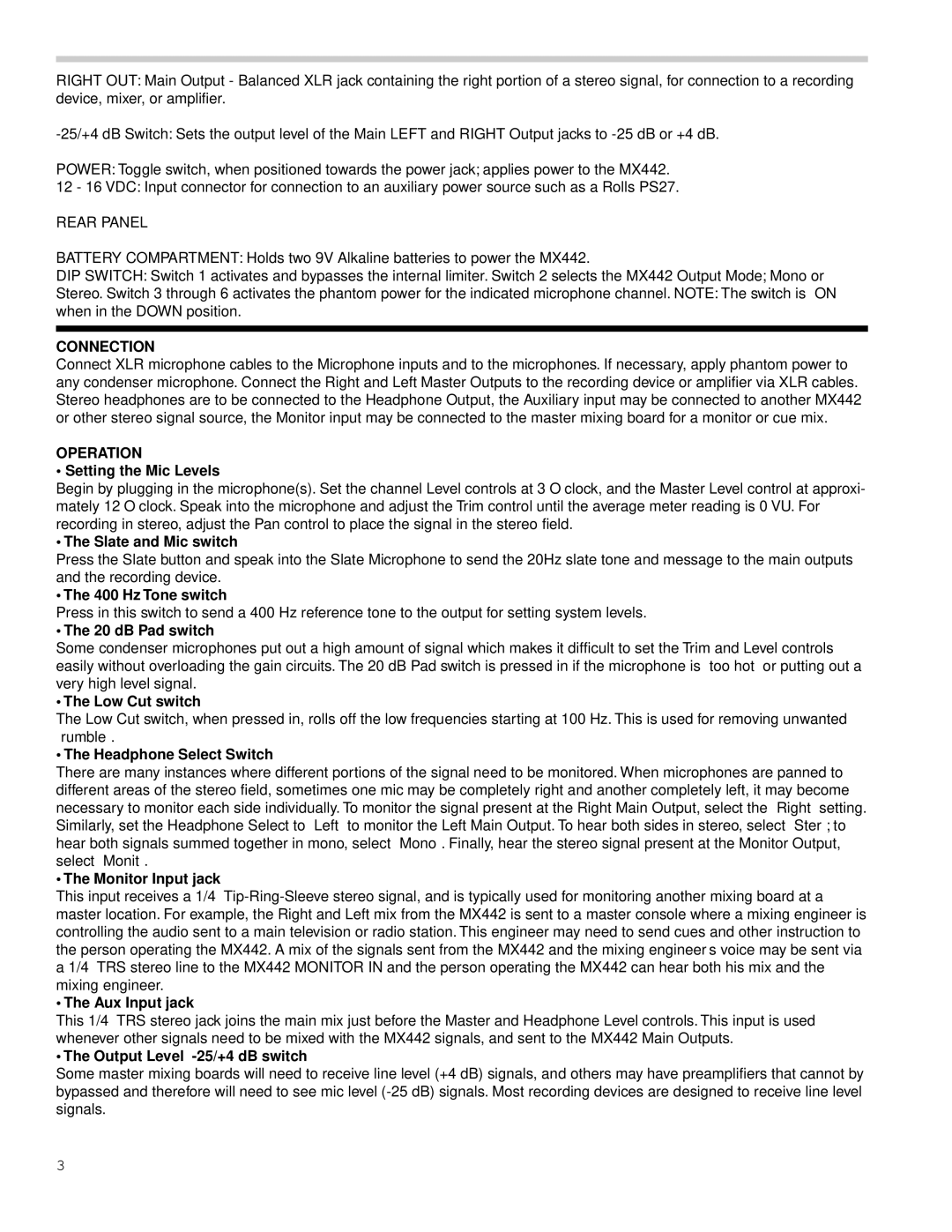
RIGHT OUT: Main Output - Balanced XLR jack containing the right portion of a stereo signal, for connection to a recording device, mixer, or amplifier.
POWER: Toggle switch, when positioned towards the power jack; applies power to the MX442.
12 - 16 VDC: Input connector for connection to an auxiliary power source such as a Rolls PS27.
REAR PANEL
BATTERY COMPARTMENT: Holds two 9V Alkaline batteries to power the MX442.
DIP SWITCH: Switch 1 activates and bypasses the internal limiter. Switch 2 selects the MX442 Output Mode; Mono or
Stereo. Switch 3 through 6 activates the phantom power for the indicated microphone channel. NOTE: The switch is “ON” when in the DOWN position.
CONNECTION
Connect XLR microphone cables to the Microphone inputs and to the microphones. If necessary, apply phantom power to any condenser microphone. Connect the Right and Left Master Outputs to the recording device or amplifier via XLR cables. Stereo headphones are to be connected to the Headphone Output, the Auxiliary input may be connected to another MX442 or other stereo signal source, the Monitor input may be connected to the master mixing board for a monitor or cue mix.
OPERATION
• Setting the Mic Levels
Begin by plugging in the microphone(s). Set the channel Level controls at 3 O’clock, and the Master Level control at approxi- mately 12 O’clock. Speak into the microphone and adjust the Trim control until the average meter reading is 0 VU. For recording in stereo, adjust the Pan control to place the signal in the stereo field.
• The Slate and Mic switch
Press the Slate button and speak into the Slate Microphone to send the 20Hz slate tone and message to the main outputs and the recording device.
• The 400 Hz Tone switch
Press in this switch to send a 400 Hz reference tone to the output for setting system levels.
• The 20 dB Pad switch
Some condenser microphones put out a high amount of signal which makes it difficult to set the Trim and Level controls easily without overloading the gain circuits. The 20 dB Pad switch is pressed in if the microphone is “too hot” or putting out a very high level signal.
• The Low Cut switch
The Low Cut switch, when pressed in, rolls off the low frequencies starting at 100 Hz. This is used for removing unwanted “rumble”.
• The Headphone Select Switch
There are many instances where different portions of the signal need to be monitored. When microphones are panned to different areas of the stereo field, sometimes one mic may be completely right and another completely left, it may become necessary to monitor each side individually. To monitor the signal present at the Right Main Output, select the “Right” setting. Similarly, set the Headphone Select to “Left” to monitor the Left Main Output. To hear both sides in stereo, select “Ster”; to hear both signals summed together in mono, select “Mono”. Finally, hear the stereo signal present at the Monitor Output, select “Monit”.
• The Monitor Input jack
This input receives a 1/4”
• The Aux Input jack
This 1/4” TRS stereo jack joins the main mix just before the Master and Headphone Level controls. This input is used whenever other signals need to be mixed with the MX442 signals, and sent to the MX442 Main Outputs.
• The Output Level -25/+4 dB switch
Some master mixing boards will need to receive line level (+4 dB) signals, and others may have preamplifiers that cannot by bypassed and therefore will need to see mic level
3
